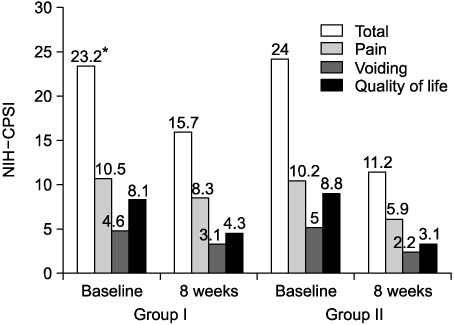Korean J Urol.
2006 May;47(5):536-540. 10.4111/kju.2006.47.5.536.
Efficacy of Combination Therapy for Patients with Chronic Prostatitis/Chronic Pelvic Pain Syndrome: A Prospective Study
- Affiliations
-
- 1Department of Urology, College of Medicine, Dongguk University, Gyeongju, Korea. delommd@hanmail.net
- KMID: 2294141
- DOI: http://doi.org/10.4111/kju.2006.47.5.536
Abstract
- PURPOSE
The National Institute of Health (NIH) category III chronic nonbacterial prostatitis/chronic pelvic pain syndromes (CPPS) are commonly seen disorders; however, there has been no consensus on how to manage these patients. The purpose of this trial was to compare the efficacy of antibiotic monotherapy and antibiotic plus alpha-blocker combination therapy for the treatment of CPPS patients.
MATERIALS AND METHODS
The study was comprised of 54 patients who were randomly placed into two groups: group I was treated with levofloxacin alone (28 patients), and group II was treated with levofloxacin and alfuzosin (26 patients). The levofloxacin, or the levofloxacin and alfuzosin were given to the respective groups for 8 weeks. The NIH Chronic Prostatitis Symptom Index (NIH-CPSI) was evaluated both before and after the treatment.
RESULTS
Before the treatment, the mean CPSI of the group I patients was 23.1+/-8.1, and after the treatment, it was 15.6+/-5.6. For the group II, the mean CPSI before the treatment was 23.9+/-8.3, and after the treatment, it was 11.0+/-4.5. The difference between the pre-and post-treatment CPSI scores of group II was significantly larger than that of group I (p=0.001). The mean differences of the CPSI from the initial scores to the final scores in both groups were followed: 2.2 in group I and 4.3 in group II for the pain domain, 1.5 in group I and 2.8 in group II for the urinary domain, and 3.8 in group I and 5.7 in group II for the quality of life domain.
CONCLUSIONS
Combination therapy of levofloxacin with alfuzosin appeared more effective for treating patients with chronic prostatitis/chronic pelvic pain syndrome than just administering antibiotic alone.
MeSH Terms
Figure
Reference
-
1. Alexander RB, Propert KJ, Schaeffer AJ, Landis JR, Nickel JC, O'Leary MP, et al. Ciprofloxacin or tamsulosin in men with chronic prostatitis/chronic pelvic pain syndrome: a randomized, double-blind trial. Ann Intern Med. 2004. 141:581–589.2. Shoskes DA, Hakim L, Ghoniem G, Jackson CL. Long-term results of multimodal therapy for chronic prostatitis/chronic pelvic pain syndrome. J Urol. 2003. 169:1406–1410.3. Nickel JC, Nyberg LM, Hennenfent M. Research guidelines for chronic prostatitis: consensus report from the first national institutes of health international prostatitis collaborative network. Urology. 1999. 54:229–233.4. Barbalias GA. Prostatodynia or painful male urethral syndrome? Urology. 1990. 36:146–153.5. Nickel JC. The three as of chronic prostatitis therapy: antibiotics, alpha-blockers and anti-inflammatories. What is the evidence? BJU Int. 2004. 94:1230–1233.6. Nickel JC, Downey J, Pontari MA, Shoskes DA, Zeitlin SI. A randomized placebo-controlled multicentre study to evaluate the safety and efficacy of finasteride for male chronic pelvic pain syndrome (category IIIA chronic nonbacterial prostatitis). BJU Int. 2004. 93:991–995.7. Nickel JC, Pontari M, Moon T, Gittelman M, Malek G, Farrington J, et al. A randomized, placebo controlled, multicenter study to evaluate the safety and efficacy of rofecoxib in the treatment of chronic nonbacterial prostatitis. J Urol. 2003. 169:1401–1405.8. Woo YN. Prostatitis. Korean J Urol. 1994. 35:575–585.9. Krieger JN, Egan KJ, Ross SO, Jacobs R, Berger RE. Chronic pelvic pains represent the most prominent urogenital symptoms of "chronic prostatitis". Urology. 1996. 48:715–722.10. Kim SW, Ha JS, Lee SJ, Cho YH, Yoon MS. Clinical effect of tamsulosin in noninflammatory chronic pelvic pain syndrome. Korean J Urol. 2003. 44:120–123.11. Nickel JC, Narayan P, McKay J, Doyle C. Treatment of chronic prostatitis/chronic pelvic pain syndrome with tamsulosin: a randomized double blind trial. J Urol. 2004. 171:1594–1597.12. Nickel JC, Downey J, Johnston B, Clark J. Canadian Prostatitis Research Group. Predictors of patient response to antibiotic therapy for the chronic prostatitis/chronic pelvic pain syndrome: a prospective multicenter clinical trial. J Urol. 2001. 165:1539–1544.13. Goto T, Makinose S, Ohi Y, Yamauchi D, Kayajima T, Nagayama K, et al. Diffusion of piperacillin, cefotiam, minocycline, amikacin, and ofloxacin into the prostate. Int J Urol. 1998. 5:243–246.14. Mehik A, Alas P, Nickel JC, Sarpola A, Helstrom PJ. Alfuzosin treatment for chronic prostatitis/chronic pelvic pain syndrome: a prospective, randomized, double-blind, placebo-controlled, pilot study. Urology. 2003. 62:425–429.
- Full Text Links
- Actions
-
Cited
- CITED
-
- Close
- Share
- Similar articles
-
- Therapeutic Options for Chronic Prostatitis/Chronic Pelvic Pain Syndrome
- UPOINT System: A Diagnostic/Therapeutic Algorithm for Chronic Prostatitis/Chronic Pelvic Pain Syndrome
- Recent trend of chronic prostatitis/chronic pelvic pain syndrome (CP/CPPS) management
- Comparison of the Efficacy of Antibiotic Monotherapy and Antibiotic Plus Alpha-blocker Combination Therapy for Patients with Inflammatory Chronic Prostatitis/Chronic Pelvic Pain Syndrome
- Neuropathic Pain in Chronic Prostatitis/Chronic Pelvic Pain Syndrome (CP/CPPS)


